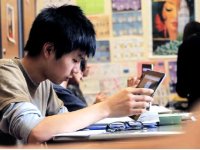Digital Citizenship: Developing a Culture of Trust and Transparency
Turning a forbidding acceptable use policy into a friendlier digital empowerment guideline can shift your school culture into a more tech-friendly place.
An acceptable use policy is a document that is present in every school district around the country. The purpose of this policy is to provide safe parameters for exploring digital resources and using school-issued devices properly. It also ensures that schools do their very best to block out the darkest corners of the web. And while these policies are effective and required, they have not evolved in their semantics.
From Acceptable to Empowered
Within the development of these school-wide policies, several shifts need to happen. My observation about the need for a semantic shift, probably one of the biggest shifts requited, reflects how acceptable use policies are interpreted by students. Essentially, these policies read more like a legal document rather than a document that students can understand and carry out. Additionally, we need to shift the focus from "you shouldn't do that" to a sense of empowerment around technology. In short, schools should place a positive connotation around technology use.
Some districts have started implementing responsible digital use guidelines or empowered digital use policies. Regardless of the title you choose, it should provide a sense of purpose for using technology beyond the idea that "said devices may get me in trouble." Similarly, this policy should be something that all students can understand and interpret. It should be simple and direct without creating an air of fear when signing on the dotted line.
Here is an example that I've used to begin simplifying my district's Empowered Digital Use Policy:
- Use digital devices, networks, and software in school for educational purposes and activities
- Keep my personal information (including home/mobile phone number, mailing address, and user password) and that of others private
- Show respect for myself and others when using technology including social media
- Give acknowledgement to others for their ideas and work
- Report inappropriate use of technology immediately.
This novel policy fits within the parameters of the Child Online Protection Act (COPA) and the Children's Internet Protection Act (CIPA) and doesn't cloud the tasks with lofty, legal verbiage. Another great resource for developing a school-wide policy for digital use is the wiki Unmasking the Digital Truth created by Dr. Wesley Fryer. Dr. Fryer breaks down the legal verbiage for each policy enacted by the federal government and shares what schools must comply with and what they can allow.
Health, Wellness, and Information
Once you've developed a policy, it's time to introduce the concept of digital health and wellness to students. This term may sound like I'm talking about calorie-counting apps, but it actually refers to making good choices online much like you would for your body's health. One of the best places to start is Common Sense Media. They offer iBooks and printable digital citizenship curriculum for grades K-12. These resources look great on an iPad, but they also offer a printable scope and sequence curriculum that allow teachers to prepare students for engaging in a digital space.
Beyond creating policy and teaching digital citizenship concepts, schools must include parents in these conversations around digital health and wellness. One of the biggest challenges for parents and schools is to develop policies and practice for a subject matter that is constantly in motion. As soon as you feel like you've gotten a handle on Instagram and Snapchat, something else comes along -- like Yik Yak -- that throws a curveball into every policy and practice you've created.
In my roles as both an instructional technology specialist and a director of technology, I used a variety of resources to make every attempt at staying ahead of the curve so that I could help the district, teachers, and parents understand what applications were out there and which of them posed an issue. Additionally, to inform parents on these new apps, I would offer community tech nights in our district. These events had a focused topic and took place in the evening. I targeted them toward parents but invited all community members to participate. The purpose was to share information about what apps students were using in class and what apps they might be using outside of school. In addition to the informative pieces, we would segue into a workshop setting where attendees could actually use the app itself to better understand how it works.
Whether your district employs technology or is just beginning to plan, it's never too late to start integrating lessons on digital citizenship. The two key elements in developing a healthy digital culture in your school are leading with transparency and establishing trust. Administrators and teachers need to place their trust in students and empower them to use the technology provided. This includes technology directors who may occasionally find it easier to block the entire internet rather than allow access to digital information. School administrators and teachers should also be upfront and open with the parents about what applications or digital resources they are incorporating into the classroom. If trust and transparency are leading your technology initiatives, schools will begin to see great successes in teaching and learning.
